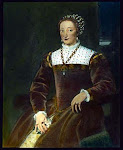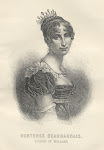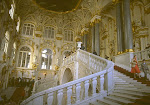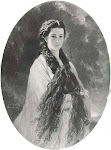
Yesterday, Sandra Gulland's new book titled Mistress of the Sun was released in the United States. For those of you who aren't familiar with her, she is the critically acclaimed author of the trilogy of novels about Josephine Barnoparte. I've mentioned the trilogy before on my blog because I enjoyed them so much and Sandra really brought the Empress Josephine to life. And because I love QUEENS so much---well, of course I loved that. Her new book is about the life of Louise de la Valliere who was the much beloved mistress of the famous Louis XIV of France.
I'm amazed at her work, really. I was lucky enough to chat with her recently online in a royalty group and she graciously agreed to tell me about the process of writing the book. Right now she is on a publicity tour throughout the U.S. If you have a chance to read the book, please do so. I can highly recommend it. I was lucky enough to get an advanced copy and I can tell you that I was immersed in the court life which took place centuries ago in France. Louise was not a Queen...but, if things had been just a little different, she might have been.
Here's the interview:
*******
Sandra, one of the reviews for your new book really caught my eye...."No one gets more deeply into the heart and mind of a historical character than Sandra Gulland. In Mistress of the Sun, the joys and sorrows of Louise de la Vallière are so real and immediate that I now feel as if Louis XIV's first mistress was a dear friend." -- Susanne Dunlap, author of Lizst's Kiss
How do you manage to give your characters such depth and such soul?
It comes down to imagining what it was truly like for a character — but this is not something that comes naturally or easily. It takes countless drafts to reveal a character's emotional reality: What was it really like for her? How did she really feel? Creating multi-dimensional characters is also something that develops over time, over many drafts. A character may be wooden and one-dimensional in early drafts, and then slowly begin to round out, to flower. Details make a difference.
Please tell us about your new book, Mistress of the Sun.
Set in 17th century France, Mistress of the Sun is a novel about Louise de la Vallière, a name that will likely be unfamiliar to people outside of France. As mistress to Louis XIV, the Sun King, she was, in effect, the "real" wife to one of the most powerful and charismatic kings in history.It's a remarkable period, at the early stages of modernism, yet with strong elements of the Middle Ages. Witchcraft was no longer punishable by death, for example, but that didn't mean it wasn't practiced: and with dire results. What interested me most was the use of "bone magic," a type of witchcraft practiced on horses.
Why did you choose 'The Mistress' ? What was it about Louise de la Valliere that appealed to you?
Louise was reported to be shy and timid, yet she was something of a tomboy, extraordinarily daring on horseback. She was sincerely devout, yet she became France's official "fallen woman." Like Josephine, she was an unlikely young woman to rise to such a prominent position. She was of relatively modest birth, an unambitious and, although cultured and intellectual, a somewhat unsophisticated young woman. It was the contradiction of all these elements that drew me to her ... but most of all, it was her amazing horsemanship. Clearly, this was a young woman who was spending most her her time on the back of a horse. She was not at all typical of the women of the period.
You seem to be drawn to royal figures. What intrigues you about them?
On a practical level, I’m interested in the lives of real people, and royal lives are documented. I will read a biography and get interested — so visibility is part of it. With both Josephine and Louise, however, what interested me is that they were not born into that royal world ... so it’s not hard to identify with them. They are like strangers in a foreign land, and we make that journey with them.
Could you tell us a little about your writing process for "The Mistress of the Sun?"
I started to write about Louise after I finished The Last Great Dance on Earth, the first of the Josephine B. Trilogy. I thought I would take a year off from Josephine’s story and sketch out the rough draft of a novel about Louise before returning to Josephine. (An unrealistic plan!) I was about six months into a novel about Louise, and quite caught up in it, when I was offered a contract for the Trilogy. At that point I had to drop everything and jump back into Josephine’s world. I put my notes and pages about Louise in a box: I told myself I would get back to this novel after I finished the Trilogy. Of course, it was many years! In 2000, after the publication of The Last Great Dance on Earth, the last of the Trilogy, I opened that box. By that time, I had three novels published, and I knew a bit more about what it took to write a historical novel. For one, I needed to do considerable research. It took time for me to collect resources and become comfortable in a 17th century setting. In particular, I also understood what a challenging story Louise’s would be to tell, that it would be hard to make work, impossible! After writing a (flat) first draft, I decided to write about La Grande Mademoiselle instead. That didn’t work either. So I thought I’d add Athénaïs, Marquise de Montespan, into the mix: that didn’t work. You have to understand that each of these dead-ends took a year. Then I tried mixing the three stories together: what a mess. Ultimately, after many years, I sent a draft that told the stories of both Louise and La Grande Mademoiselle to my agent. She reported back that she really liked Louise’s story. I was so relieved! Later she mentioned, over lunch, as if in passing, that La Grande Mademoiselle didn’t really come to life for her. I returned home pleased with the feedback—until I realized that the part that didn’t work was well over half of the manuscript. At that point I decided that I was just going to have to brave it and tell Louise’s story. I went back to my original notes and started again. It was a long, arduous process: many, many drafts, and many up-to-the wire additions and deletions. It wasn’t until the very last that I knew how it would end, for example.
I know it is now available in Canada. When will the book be released in the USA?
Mistress of the Sun is officially out in the U.S. June 3.
Before you wrote your current book, you were very busy with your Josephine Bonaparte trilogy, which is so widely popular. Could you tell us a little about what you loved about Josephine and the process of writing about her?
Josephine was a lovely person to spend a decade with. She was savvy and sympathetic, loyal — a really good people-person — but the most amazing thing about her from a writing perspective is that she was right at the center of what was happening in France through many changes in government. She had the best view, you might say, of anyone. Through her eyes, you could see it all unfolding. There aren’t many people in history with such a dramatic life story, both on the personal and political levels. For a novelist, Josephine’s life was like a treasure chest of riches. I was astonished that more hadn’t been written about her.
Do you miss Josephine? Was it hard putting her books away and preparing for a new subject?
It was quite hard to finish the Trilogy, knowing that that would be the end of my close involvement with Josephine and her world. I felt numb for a period of time. After about six months, I made the bold decision to sell my collection of Napoleonic books: on a practical level I needed room for books on my new subjects, but also, I think I needed to draw a line for myself, make it clear that I wasn’t going back to that period in history. I kept a small shelf of my favorites, my treasures, but let the others go: hundreds of titles. It was wrenching, but the right thing to do.
Now that you have finished Mistress of the Sun, do you miss Louise?
I’m very fond of Louise; there is still a strong connection for me. I think if I had to chose between Josephine and Louise (and it’s impossible, of course), I would prefer to have Josephine as a friend, but I would prefer to be Louise — not to have her life, which was so hard, but to have her ardent passion. What I will miss most in moving on from Mistress of the Sun is researching 17th century horsemanship, which was a significant and fascinating part of all my years working on Louise’s story.
Personally, I can't wait to get my hands on a copy. I'm sure many readers feel that way. Is there anything you'd like your fellow royal lovers to know about Louise de la Valliere?
The French translator of the Josephine B. Trilogy recently read Mistress of the Sun and reported back that he liked that I wrote about, in his words, “women of silent power.” I like that. Women of the past were often silent—and silenced—but that didn’t mean that they were without power.Can we look forward to another book in the future about a royal subject? No doubt! I’ve been thinking about a member of the royal family, La Grande Mademoiselle, the Sun King’s cousin — an early feminist, an eccentric, the wealthiest person in Europe. If I do write about her, it will be a departure for me, for she was born and raised with the expectation that she would be a queen.
******
Sandra is the ultimate "Queen Writer" !!
















+Mary++Princess+of+OrANGE.jpg)



































.jpg)







.png)












